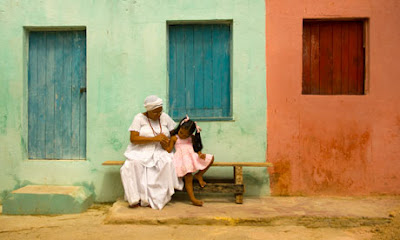 |
| Women of Candomble in Salvador Bahia, Brazil. Image via Antropologia Teatru |
Many churches and religious organizations have not taken the most progressive stance when it comes to issues such as AIDS, contraception, abortion, and sexual orientation. The response of many organizations has been condemnation and in some cases outright denial that a particular issue is a problem. The churches’ response has often been out of step with the needs of those it is meant to serve. However, there are many churches from all religious denominations working to change that, and they have taken proactive steps to help provide counsel to all people, as well as access to services relevant to the community’s needs. One example of this is the Brazilian religion Candomble. Candomble houses of worship, called terreiros, are taking innovative approaches to addressing the needs of the Brazilian people.
 |
| The AIDS awareness symbol was installed at the foot of Rio's iconic Christ the Redeemer statue for World AIDS Day. Photo by Ricardo Moraes |
The AIDS epidemic has affected people from all levels of society, including members of various Candomble terreiros. Many of these houses of worship began to partner with NGOs to combat the spread of the virus. They have created and distributed prevention awareness materials reflecting the cultural and spiritual beliefs of their communities. Odo-Ya! A prevention education program, produced a comic book featuring orixas (pronounced oh-ree-shah, African-based spiritual deities worshiped by Candomble practicioners). The comic book depicted the orixas coming to those afflicted or at risk and embracing them in their hour of need. “Odo-Ya! is the name of a comic book created by Candomble devotees to teach about AIDS from a Candomble perspective: spiritual, life-affirming, and sex-positive,” writes filmmaker Tania Cypriano, whose documentary Odo Ya! Life With Aids tells the story of how Candomble fellowship “has become a source of strength and power for a group of AIDS sufferers.”
Indeed, sex is viewed quite differently in the orixa mythology than it is in Christianity or Catholicism, where emphasis has traditionally been on abstinence. Instead, it is seen as one of the natural realities of life. The orixa Oxum (pronounced oh-shoom) is said to rule over love, beauty, and sexuality. She is known to be a protector of prostitutes, and in some religious stories, Oxum herself is a prostitute.
 |
| Illustration of Oxum from Odo-Ya! AIDS education comic book. Image via Osun across the Waters |
 |
| Maria Davina Rodrigues, a former sex worker who takes in abandoned street children in Salvador. Image via Bahia-Online |
Innovative outreach approaches to care and prevention have lead many in the public health field to look to Brazil as an example for what can be done elsewhere. “Over the course of recent years, international attention has increasingly focused on the multidimensional range of HIV and AIDS prevention and control activities developed in Brazil by governmental AIDS programs and non-governmental AIDS service organizations and other sectors of civil society…and, it has come to be described by some as a “Brazilian model” for the response to AIDS...not only as perhaps the most successful experience yet realized by any developing country, but perhaps anywhere,” writes Richard Parker, Director and President of the Brazilian Interdisciplinary AIDS Association.
In 2001, the National Network of Afro-Brazilian Religions and Health was established to take on a host of health issues effecting Brazil’s Black population and politicize communities. The debate about prevention methods is ongoing, and researchers and organizers say several key elements must be taken into account: racial discrimination, poverty, gender inequality, and sexuality.
A wealth of information has come from researchers Cristiane Goncalves da Silva, Jonathan Garcia, Fernando Seffner, Luis Felipe Rios, and Richard Parker, who conducted interviews with members of Candomble terreiros. Their research, entitled African-Brazilian Religions and the Combat of HIV/AIDS in Brazil in Rio de Janeiro, Porto Alegre, Recife, and Sao Paolo (translated from Portuguese) gives us greater perspective on the ideals of Candomble practicioners and their connection to the communities in which they live. "The narratives of respondents show that most African Brazilian leaders tend to accept sexual diversity and a host of marginalized people into the terreiros. Among the leaders interviewed, we have an HIV positive pai de santo (Candomble priest) who speaks about his homosexual [experiences] in the army, and many maes de santo (Candomble priestesses) who speak about how love and sex are the same between any couple. a pai de santo of several filhas de santo (members of the terreiro congregation) are transvestites and sex workers."
 |
| Candomble priestess and child. Image by Annie Belt/Corbis |
It seems that a major part of the "Brazilian model" for fighting the spread of AIDS is acceptance, and developing an understanding of key factors that effect general health and access to information, such as socioeconomic status, discrimination, and sexual orientation. Prevention outreach methods are diverse, including secular ones (HIV positive characters are featured on telenovelas (soap operas) taking Anti Retro Viral medications, for example). Fellowship, community, and having a place where one is accepted for who they are can play a key part in one's health and well being. It's great to know that all over the world, there are religious congregations providing that support.
